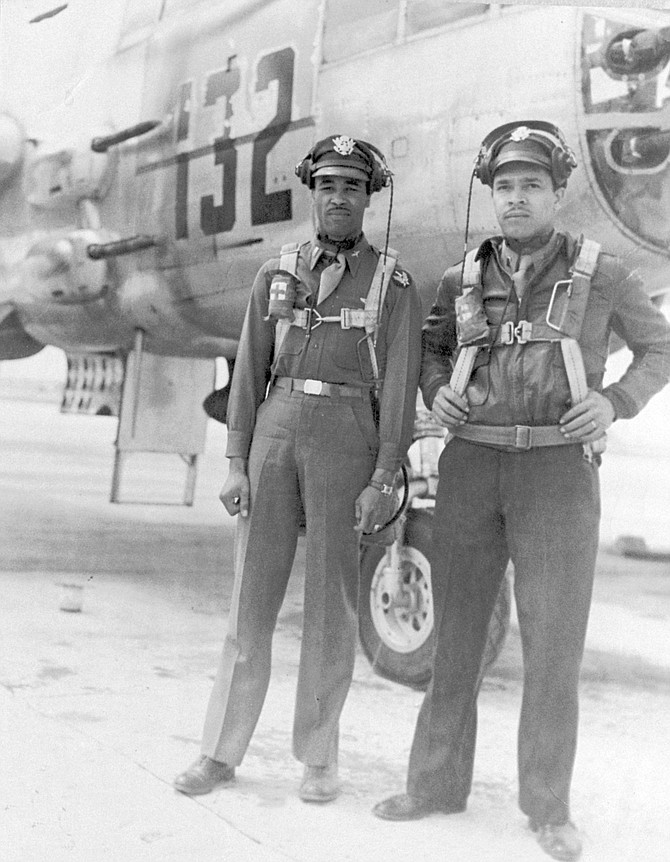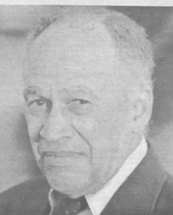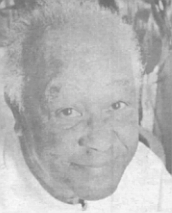 Facebook
Facebook
 X
X
 Instagram
Instagram
 TikTok
TikTok
 Youtube
Youtube

During World War II, Germans called them the schwartze vogelmenschen or “black birdmen.” White American bomber crews called them the Black Redtail Angels. Various other white Americans called them spades, spooks, coons, or sambos, and not even in the two-block town of Ajo, Arizona, could they sit down in a restaurant and be served.

When an Ajo waitress told Alfonso L. Harris and his gunnery school classmates that she’d lose her job if she served them, it was 1944, and Harris and his friends were officers headed for a war. More specifically, they were Tuskegee Airmen, part of a government experiment to see whether black men, who had been excluded from all but the most menial military training until 1941, could fly fighter planes and bombers.
The 73-year-old Harris, who now lives in Oceanside, was not unacquainted with prejudice when he arrived in Ajo. He grew up under the de jure discrimination of Dallas, Texas, graduated from high school just after his 15th birthday, and moved to Utah, where he finished at the top of his class in aircraft mechanics.

Although his high ranking earned him a job as an inspector at Hillfield Air Depot, less qualified men were continually promoted above him. When asked why, Harris’s supervisor explained that in wartime, he couldn’t risk putting a black man — whose orders many white men would ignore — in a position of authority. As an inspector, Harris worked among lifesize versions of the model planes he’d built in boyhood. They were flown by pilots in white scarves, jodhpur boots, and hats wrinkled by the “50-mission crush" — the coveted mark of earphones. Flying, Harris decided, was the job for him.
When he heard Mississippi’s Senator Bilbo declare his skepticism about the Tuskegee project (“The blacks can hardly drive the trucks,” Harris recalls Bilbo saying, “so why would you want to put blacks into an expensive airplane?"), Harris was even more determined. He joined the Army Air Corps in 1944 but didn’t graduate from flight school until October of 1945 — after V-E and V-J day.
Retired Lieutenant Colonel Eugene C. Cheatham, Jr., an 85-year-old Tuskegee Airman now living in Spring Valley, had been just as determined to fly, and although his class — the 617th squadron of the 477th Bomber Group — graduated in 1943, they never made it overseas, either.
“No general wanted the black troops,” Cheatham says, except as cooks and truck drivers. “It was a matter of record.” This was, naturally, a disappointment, especially given what Cheatham had gone through to reach Cheaha, Alabama, in the first place.
During his dental exam, he says, the dentist spent 15 minutes prying a filling out of his mouth — chipping a tooth in the process — in order to disqualify him. Cheatham promptly had the tooth filled and returned to pass the exam. When he scored above the 30 or 40 white men who took the written test with him, the examiner told Cheatham he’d have to take it over.
Cheatham missed one question the second time.
“So there was nothing they could say," he says. “I qualified.’"
Still, Cheatham waited and waited to receive orders. Nine white men who had taken the physical exam with him wrote or called to say they’d been accepted into the Air Corps, but Cheatham received no news. He asked for time off to go to Washington and ask the President himself what had happened.
“Boy, did I get the runaround,” Cheatham says. “I saw nobody.” But after fruitlessly wandering the halls of the War Department for a week, he chanced to see the office of the Civilian Aid to the Secretary of War, William H. Hastie, a black man who had been a federal judge in the Virgin Islands. Hasty heard Cheatham’s story and told him to go home, expecting good news. Cheatham finally received his ticket to Cheaha, Alabama, in March of 1943.
In all, 450 black fighter pilots — slightly more than half of the aviators trained at the Tuskegee Institute — fought in the aerial war over North Africa, Sicily, and Europe. They flew 15,553 sorties and completed 1578 missions. Sixty-six pilots were killed in aerial combat, and 32 were forced down or shot down and captured.
Alfonso Harris left the Army Air Force after V-J day when he learned that pilots who wished to remain would have to accept noncommissioned officer status. He joined his aunt in Los Angeles, earned a B.S. in physics at UCLA, and worked for 33 years as a physicist and engineer.
Eugene Cheatham stayed in the service as a reservist for 20 years, serving as an intelligence officer and flying 150 combat missions in the Korean War. He received the Air Medal for his service but not in the usual manner. He returned to his tent one day to find that his colonel had, instead of presenting the medal to him, simply tossed it on his bed. He retired as a Lieutenant Colonel in 1964.
San Diego County is home to at least five Tuskegee Airmen who learned to fly under similar conditions, and Alfonso Harris and Bob Maxwell will talk about their experiences next week in the community room of the Oceanside Mission Branch library.


During World War II, Germans called them the schwartze vogelmenschen or “black birdmen.” White American bomber crews called them the Black Redtail Angels. Various other white Americans called them spades, spooks, coons, or sambos, and not even in the two-block town of Ajo, Arizona, could they sit down in a restaurant and be served.

When an Ajo waitress told Alfonso L. Harris and his gunnery school classmates that she’d lose her job if she served them, it was 1944, and Harris and his friends were officers headed for a war. More specifically, they were Tuskegee Airmen, part of a government experiment to see whether black men, who had been excluded from all but the most menial military training until 1941, could fly fighter planes and bombers.
The 73-year-old Harris, who now lives in Oceanside, was not unacquainted with prejudice when he arrived in Ajo. He grew up under the de jure discrimination of Dallas, Texas, graduated from high school just after his 15th birthday, and moved to Utah, where he finished at the top of his class in aircraft mechanics.

Although his high ranking earned him a job as an inspector at Hillfield Air Depot, less qualified men were continually promoted above him. When asked why, Harris’s supervisor explained that in wartime, he couldn’t risk putting a black man — whose orders many white men would ignore — in a position of authority. As an inspector, Harris worked among lifesize versions of the model planes he’d built in boyhood. They were flown by pilots in white scarves, jodhpur boots, and hats wrinkled by the “50-mission crush" — the coveted mark of earphones. Flying, Harris decided, was the job for him.
When he heard Mississippi’s Senator Bilbo declare his skepticism about the Tuskegee project (“The blacks can hardly drive the trucks,” Harris recalls Bilbo saying, “so why would you want to put blacks into an expensive airplane?"), Harris was even more determined. He joined the Army Air Corps in 1944 but didn’t graduate from flight school until October of 1945 — after V-E and V-J day.
Retired Lieutenant Colonel Eugene C. Cheatham, Jr., an 85-year-old Tuskegee Airman now living in Spring Valley, had been just as determined to fly, and although his class — the 617th squadron of the 477th Bomber Group — graduated in 1943, they never made it overseas, either.
“No general wanted the black troops,” Cheatham says, except as cooks and truck drivers. “It was a matter of record.” This was, naturally, a disappointment, especially given what Cheatham had gone through to reach Cheaha, Alabama, in the first place.
During his dental exam, he says, the dentist spent 15 minutes prying a filling out of his mouth — chipping a tooth in the process — in order to disqualify him. Cheatham promptly had the tooth filled and returned to pass the exam. When he scored above the 30 or 40 white men who took the written test with him, the examiner told Cheatham he’d have to take it over.
Cheatham missed one question the second time.
“So there was nothing they could say," he says. “I qualified.’"
Still, Cheatham waited and waited to receive orders. Nine white men who had taken the physical exam with him wrote or called to say they’d been accepted into the Air Corps, but Cheatham received no news. He asked for time off to go to Washington and ask the President himself what had happened.
“Boy, did I get the runaround,” Cheatham says. “I saw nobody.” But after fruitlessly wandering the halls of the War Department for a week, he chanced to see the office of the Civilian Aid to the Secretary of War, William H. Hastie, a black man who had been a federal judge in the Virgin Islands. Hasty heard Cheatham’s story and told him to go home, expecting good news. Cheatham finally received his ticket to Cheaha, Alabama, in March of 1943.
In all, 450 black fighter pilots — slightly more than half of the aviators trained at the Tuskegee Institute — fought in the aerial war over North Africa, Sicily, and Europe. They flew 15,553 sorties and completed 1578 missions. Sixty-six pilots were killed in aerial combat, and 32 were forced down or shot down and captured.
Alfonso Harris left the Army Air Force after V-J day when he learned that pilots who wished to remain would have to accept noncommissioned officer status. He joined his aunt in Los Angeles, earned a B.S. in physics at UCLA, and worked for 33 years as a physicist and engineer.
Eugene Cheatham stayed in the service as a reservist for 20 years, serving as an intelligence officer and flying 150 combat missions in the Korean War. He received the Air Medal for his service but not in the usual manner. He returned to his tent one day to find that his colonel had, instead of presenting the medal to him, simply tossed it on his bed. He retired as a Lieutenant Colonel in 1964.
San Diego County is home to at least five Tuskegee Airmen who learned to fly under similar conditions, and Alfonso Harris and Bob Maxwell will talk about their experiences next week in the community room of the Oceanside Mission Branch library.
Comments